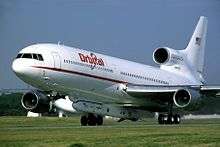Stargazer (aircraft)
| Stargazer | |
|---|---|
.jpg) | |
| "Stargazer" flying over the Atlantic Ocean carrying a Pegasus XL rocket | |
| Type | Lockheed L-1011 TriStar |
| Registration | N140SC |
| Owners and operators | Orbital ATK Northrop Grumman |
| Status | Active |
Stargazer, registration number N140SC, is a Lockheed L-1011 TriStar built in 1974, that was modified in 1994 to be used by Orbital Sciences (later Orbital ATK, now Northrop Grumman) as a mother ship launch pad for Pegasus rockets. As of December 2016, 43 rockets (containing 94 satellites) have been launched from it, using the Pegasus-H and Pegasus-XL configurations.[1][2]
History
The first Pegasus launch to use Stargazer was conducted on 27 June 1994, and was the maiden flight of the Pegasus-XL. Previous launches used the NASA-operated Boeing NB-52B Balls 8, which was also used for four subsequent launches, as the original Pegasus could not be launched from Stargazer due to clearance issues. A modified version, the Pegasus-H, was introduced to rectify this.
In addition to Pegasus launches, Stargazer was used for captive tests and transportation of the X-34 hypersonic research aircraft; however, drop tests used Balls 8. Orbital Sciences also offer the aircraft for research flights.[3] It is capable of carrying a 23,000 kilograms (51,000 lb) payload to an altitude of 12,800 metres (42,000 ft).[4]

Pegasus launches using Stargazer are usually conducted from Vandenberg Air Force Base. However, launches have also been conducted from the Cape Canaveral Air Force Station, the NASA Kennedy Space Center, the NASA Wallops Flight Facility and from launch sites outside the United States: Kwajalein Atoll in the Marshall Islands and Gando Airport in Spain.[5]
In 2015, Stargazer was re-painted to reflect Orbital Sciences' merger with Alliant Techsystems.[6]
On 15 December 2016, Stargazer launched CYGNSS on behalf of NASA on its second attempt; the first was scrubbed on 12 December due to issues with the hydraulic system responsible for separating the Pegasus rocket from the launch aircraft. [7]
See also
| Wikimedia Commons has media related to Stargazer (aircraft). |
References
- ↑ http://www.airframes.org/reg/n140sc
- ↑ "Orbital ATK Pegasus". Orbital Sciences Corporation. Retrieved 2018-02-28.
- ↑ ""Stargazer" L-1011 Carrier Aircraft". Orbital Sciences Corporation. Retrieved 2009-02-20.
- ↑ "L-1011 Fact Sheet" (PDF). Orbital Sciences Corporation. Retrieved 2009-02-20.
- ↑ Krebs, Gunter. "Pegasus". Gunter's Space Page. Retrieved 2009-02-20.
- ↑ Ray, Justin. "Photo: New Orbital ATK paint job for Pegasus carrier jet". Spaceflight Now. Spaceflight Now Inc. Retrieved 9 June 2016.
- ↑ http://www.universetoday.com/132395/hydraulic-pump-glitch-aborts-nasas-hurricane-microsat-fleet-launch-to-dec-14-live-coverage/